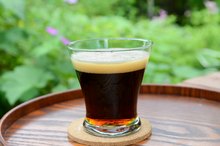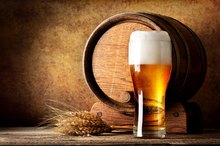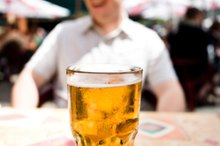Calories in a Rolling Rock Beer
Calories are used to measure the amount of energy in food and are available on the Nutrition Facts label found on food products, as required by the Food and Drug Administration. Alcoholic beverages, however, are regulated by the Alcohol and Tobacco Tax and Trade Bureau, which does not require a nutrition label on alcohol-containing products. Many companies that sell alcoholic beverages, like Rolling Rock, provide nutritional information on their websites and sometimes on their product.
Identification
A kilocalorie, or kcal, is the standard measurement of food energy and is sometimes referred to as a Calorie, with a capital C. A Calorie is equivalent to the amount of energy needed to increase the temperature of 1kg of water by 1 degree Celsius. Calories are available on almost all food and drink products. Rolling Rock, an American lager, was founded in a small town in Pennsylvania in 1939. The beer can be recognized by its distinctive green bottle and painted-on label.
Features
Calories of Guinness Stout Beer
Learn More
According to Rolling Rock's website, its national beer, a premium extra pale lager, contains 132 calories per 12 fl. oz. It is 4.5 percent alcohol by volume and also provides 10g of carbohydrates, 1.3g of protein and 0g of fat per 12 fl. oz. It has a light to medium body and color. Ingredients include pale barley malt, a blend of hops, rice and corn.
Considerations
Knowing the calories in your beer is important when you are trying to watch your weight and your caloric intake. Another consideration to keep in mind when consuming alcohol is that the digestion and metabolism of alcohol in your body is different than food. When alcohol enters your body, its digestion is given priority over all nutrients you consume and will slow your metabolism.
Misconceptions
How Many Calories Are in Malt Liquor?
Learn More
One misconception about calories in beer is that the calories will lead to a beer belly. The truth about beer bellies is that excess calories above your need is what causes fat deposits in your abdominal region. It is possible to consume alcohol, in moderation, and avoid a beer belly by monitoring your total caloric intake. Keep this in mind when consuming alcohol and try to cut back on portions of your food to spare calories.
Warning
According to a 2006 study published in NeuroImage, low doses of alcohol substantially decrease glucose metabolism in the human brain, leading to alcohol-induced decreases in brain activity. This study adds information to what is known about the health consequences due to the consumption of alcohol. It is important for you to keep your alcohol consumption at or below recommended levels. The National Institute of Health recommends that if you are going to consume alcoholic beverages, to do so in moderation--two drinks per day for men and one drink per day for women.
Related Articles
References
- Rolling Rock: About the Beer
- "NeuroImage"; Low Doses of Alcohol Substantially Decrease Glucose Metabolism in the Human Brain; N.D. Volkow, et al; January 2006
Resources
Writer Bio
Terry Papadopoulos is a registered dietitian who has been writing reliable and easy to understand nutrition information for the public since 2009. He earned a Master of Science in health and nutrition from the University of North Florida and a Bachelor of Science in food and nutrition from Florida State University. He is also a NHE-certified fitness nutritionist.









